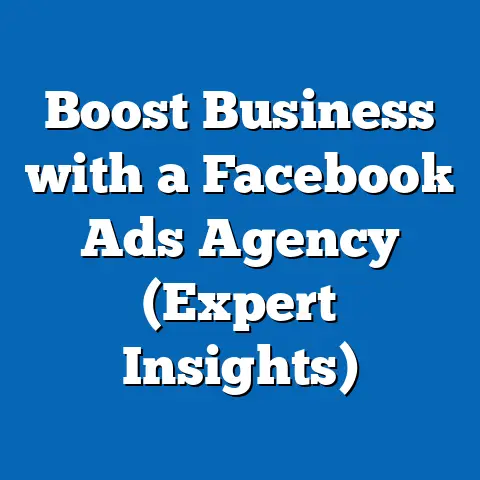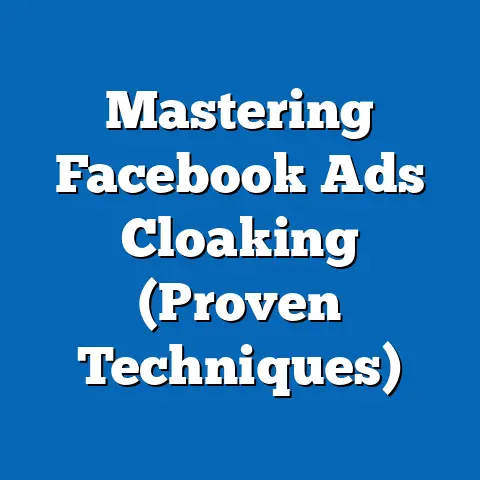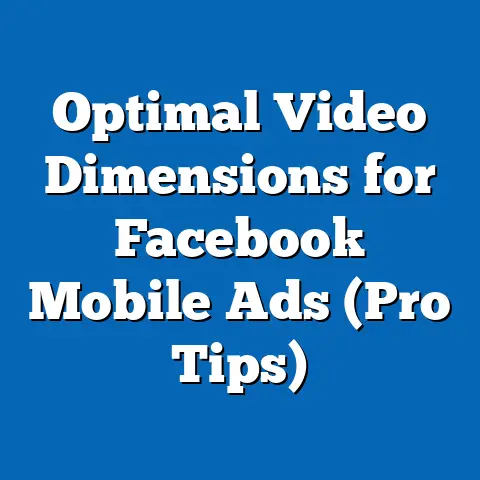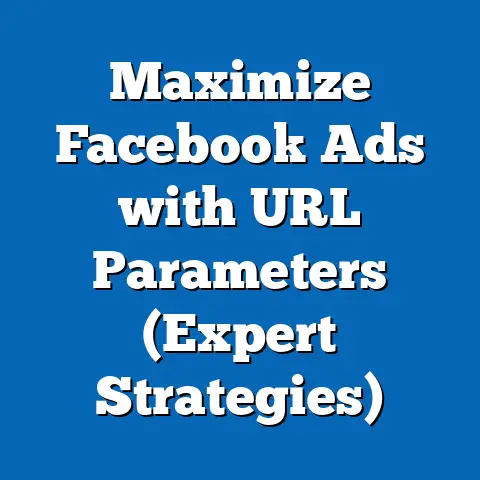Unlock Facebook Ad Video Success (Proven Template Guide)
Have you ever felt like you’re throwing money into a black hole with your Facebook ads? You see other businesses thriving, their ads popping up everywhere, filled with engaging videos that seem to effortlessly attract customers. Meanwhile, your own campaigns are sputtering, barely making a dent, and leaving you wondering where you went wrong. I’ve been there. I remember one client in particular, a local bakery, who was ready to give up on Facebook ads entirely. They’d tried everything, or so they thought. Static images, clever copy, even running contests, but nothing seemed to stick. The frustration was palpable, the feeling of being left behind as competitors reaped the rewards of successful video ads.
But what if I told you there’s a proven template, a secret sauce if you will, that can transform your Facebook ad performance and unlock the true potential of video? It’s not magic, but a strategic framework that leverages the power of visual storytelling to connect with your audience on a deeper level and drive results. I’m going to share that template with you. This isn’t just about creating pretty videos; it’s about crafting compelling narratives that resonate with your ideal customer, capture their attention, and ultimately, convert them into loyal fans.
The Power of Video Ads on Facebook
Video isn’t just a trend; it’s the dominant language of the internet. On Facebook, this is especially true. Think about your own scrolling habits. What catches your eye? Is it a wall of text, or a captivating video playing silently in your feed? For me, it’s almost always the video.
The statistics don’t lie. Studies consistently show that video ads generate significantly higher engagement rates than static images or text-based ads. In fact, according to a report by HubSpot, videos on social media generate 1200% more shares than text and images combined. That’s a massive difference!
But it’s not just about shares. Video ads are also incredibly effective at driving conversions. A recent survey by Wyzowl found that 87% of marketers say video has increased traffic to their website, and 80% say video has directly helped increase sales.
I’ve seen this firsthand. Remember that bakery I mentioned earlier? After implementing a video ad strategy, focusing on short, mouth-watering videos of their signature pastries, they saw a 30% increase in online orders within just a few weeks. The key? They weren’t just showing off their delicious creations; they were telling a story. They showcased the passion and craftsmanship that went into each pastry, creating an emotional connection with their audience.
Consider these real-world examples:
- Dollar Shave Club: Their viral video ad, a low-budget yet hilarious production, catapulted them to success, disrupting the razor industry and proving that you don’t need a huge budget to create an impactful video.
- Airbnb: Their video ads often focus on showcasing unique experiences and connecting travelers with local hosts, creating a sense of community and adventure that resonates with their target audience.
- GoPro: Their video ads are filled with stunning user-generated content, showcasing the capabilities of their cameras and inspiring viewers to capture their own adventures.
These brands understand the power of storytelling. They know that emotions drive consumer behavior. A well-crafted video ad can tap into those emotions, creating a lasting impression and driving action.
Key Takeaway: Video ads are not just a nice-to-have; they’re a must-have for any business looking to succeed on Facebook. They offer unparalleled engagement and conversion potential, allowing you to connect with your audience on a deeper level and drive meaningful results.
Understanding Your Audience
Creating a successful video ad isn’t just about having fancy equipment or being a skilled filmmaker. It starts with understanding your audience. Who are you trying to reach? What are their pain points, their desires, their motivations?
I always tell my clients, “You’re not selling a product; you’re selling a solution.” To sell that solution effectively, you need to know the problem inside and out.
Here’s how I use it:
- Demographics: I start by looking at age, gender, education level, and relationship status. This gives me a basic understanding of who my audience is.
- Interests: I then delve into their interests, looking at the pages they like, the topics they discuss, and the activities they enjoy. This helps me understand their passions and what motivates them.
- Behaviors: Finally, I examine their behaviors, looking at their purchase history, their device usage, and their online activities. This helps me understand how they interact with Facebook and other online platforms.
But audience research doesn’t stop there. I also encourage my clients to conduct competitor analysis. What ads are their competitors running? Who are they targeting? What kind of engagement are they getting? This can provide valuable insights into what works and what doesn’t.
Once you’ve gathered enough data, it’s time to develop buyer personas. A buyer persona is a semi-fictional representation of your ideal customer. It should include details about their age, gender, occupation, interests, pain points, and motivations.
For example, let’s say you’re selling a fitness program for busy moms. Your buyer persona might look something like this:
- Name: Sarah
- Age: 35
- Occupation: Stay-at-home mom
- Interests: Healthy eating, fitness, family activities
- Pain Points: Lack of time, feeling overwhelmed, struggling to lose weight
- Motivations: To feel healthy and confident, to have more energy to play with her kids, to be a good role model for her family.
By understanding Sarah’s pain points and motivations, you can create video ads that speak directly to her needs and desires. You can showcase how your fitness program can help her overcome her challenges and achieve her goals.
Key Takeaway: Understanding your audience is crucial for creating impactful video ads. By conducting thorough audience research and developing detailed buyer personas, you can create videos that resonate with your target audience, increase engagement, and drive conversions.
The Proven Video Ad Template
Now, let’s get to the heart of the matter: the proven video ad template. This template is based on years of experience, countless A/B tests, and a deep understanding of what works on Facebook. It’s a framework that you can adapt and customize to fit your specific needs and target audience.
The template consists of five key components:
- Hook: The first few seconds of your video are crucial. You need to grab the viewer’s attention immediately and make them want to keep watching.
- Problem: Identify and present the audience’s problem in a relatable way. This establishes a connection and shows that you understand their needs.
- Solution: Introduce your product or service as the solution to their problem, highlighting its unique selling points and benefits.
- Social Proof: Build credibility by showcasing testimonials, reviews, statistics, or case studies that demonstrate the effectiveness of your product or service.
- Call to Action (CTA): Tell viewers exactly what you want them to do next, whether it’s visiting your website, signing up for a free trial, or making a purchase.
Let’s break down each component in more detail:
1. Hook:
The hook is your chance to make a first impression. It needs to be attention-grabbing, intriguing, and relevant to your target audience.
Here are a few examples of effective hooks:
- Question: “Are you tired of feeling tired?”
- Bold Statement: “This one trick can transform your business overnight.”
- Intriguing Visual: A quick glimpse of a stunning transformation or a captivating scene.
- Sound Effect: A surprising or attention-grabbing sound effect.
2. Problem:
Once you’ve hooked the viewer, it’s time to connect with them by identifying their problem. This shows that you understand their needs and that you’re not just trying to sell them something.
Here are a few tips for presenting the problem effectively:
- Be Specific: Don’t just say “Are you struggling with weight loss?” Be more specific: “Are you tired of trying countless diets that don’t work?”
- Be Relatable: Use language that your audience can understand and relate to.
- Evoke Emotion: Tap into their pain points and frustrations.
3. Solution:
Now it’s time to introduce your product or service as the solution to their problem. Highlight its unique selling points and benefits, and explain how it can help them achieve their goals.
Here are a few tips for presenting the solution effectively:
- Focus on Benefits, Not Features: Don’t just list the features of your product; explain how those features will benefit the viewer.
- Be Clear and Concise: Don’t overwhelm the viewer with too much information.
- Show, Don’t Tell: Use visuals to demonstrate how your product works and how it can help them.
4. Social Proof:
Building credibility is essential for convincing viewers that your product or service is worth their time and money. Social proof can take many forms, including:
- Testimonials: Short videos of satisfied customers sharing their positive experiences.
- Reviews: Screenshots of positive reviews from online platforms.
- Statistics: Data that demonstrates the effectiveness of your product or service.
- Case Studies: Detailed stories of how your product or service has helped other customers achieve their goals.
5. Call to Action (CTA):
The final component of the template is the call to action. This tells viewers exactly what you want them to do next.
Here are a few examples of effective CTAs:
- “Visit our website to learn more.”
- “Sign up for a free trial.”
- “Shop now and get 20% off.”
- “Download our free ebook.”
Your CTA should be clear, concise, and compelling. It should also be relevant to the content of your video.
Key Takeaway: This proven video ad template provides a framework for creating compelling narratives that resonate with your target audience, capture their attention, and drive conversions. By focusing on the hook, problem, solution, social proof, and call to action, you can create video ads that are both engaging and effective.
Crafting Compelling Video Content
Now that you understand the template, let’s talk about crafting compelling video content. This is where your creativity comes into play.
Here are a few best practices for scripting, filming, and editing videos:
- Keep it Short and Sweet: Attention spans are short, especially on social media. Aim for videos that are 15-60 seconds long.
- Focus on Visual Storytelling: Use visuals to tell your story. Show, don’t tell.
- Use High-Quality Footage: Poor quality footage can turn viewers off. Invest in good lighting and a decent camera.
- Use Captions: Many people watch videos with the sound off. Use captions to make your video accessible to everyone.
- Maintain a Consistent Brand Voice: Your video should reflect your brand’s personality and values.
I find that creating a storyboard before filming is incredibly helpful. A storyboard is a visual representation of your video, showing each scene and its corresponding dialogue or narration. This helps you plan your shots, organize your ideas, and ensure that your video flows smoothly.
There are also a ton of great tools available to help you create compelling video content. Some of my favorites include:
- Canva: A user-friendly graphic design platform that offers a variety of video templates and editing tools.
- Adobe Premiere Rush: A mobile video editing app that allows you to create professional-looking videos on the go.
- Animoto: A video creation platform that specializes in creating marketing videos.
Key Takeaway: Creating compelling video content requires a combination of creativity, technical skills, and attention to detail. By following these best practices and utilizing the right tools, you can create videos that are both engaging and effective.
Testing and Optimizing Your Video Ads
Creating a great video is only half the battle. You also need to test and optimize your ads to ensure that they’re performing at their best.
This is where A/B testing comes in. A/B testing involves creating two or more versions of your ad and testing them against each other to see which one performs better.
Here are a few things you can A/B test:
- Hook: Test different hooks to see which one grabs the most attention.
- Visuals: Test different images or video clips to see which ones resonate the most with your audience.
- Copy: Test different ad copy to see which one generates the most clicks and conversions.
- Call to Action: Test different CTAs to see which one drives the most desired action.
- Targeting: Test different targeting options to see which audience segments are most responsive to your ads.
As you run your tests, it’s important to track your key performance indicators (KPIs). These are the metrics that you’ll use to measure the success of your ads.
Some important KPIs to track include:
- View Rate: The percentage of people who watch your video.
- Engagement Rate: The percentage of people who like, comment, or share your video.
- Click-Through Rate (CTR): The percentage of people who click on your ad.
- Conversion Rate: The percentage of people who take the desired action after clicking on your ad (e.g., visiting your website, signing up for a free trial, making a purchase).
- Cost Per Acquisition (CPA): The cost of acquiring a new customer through your ad.
By tracking these KPIs, you can identify what’s working and what’s not, and make adjustments to your ads accordingly.
Key Takeaway: Testing and optimizing your video ads is an ongoing process. By continuously A/B testing different elements of your ads and tracking your KPIs, you can identify what works best for your target audience and maximize your advertising ROI.
Conclusion
Success with Facebook video ads isn’t a matter of luck; it’s a matter of strategy. By understanding the power of video, knowing your audience, using the proven template, crafting compelling content, and testing and optimizing your ads, you can unlock the true potential of Facebook video advertising and achieve your business goals.
Don’t let your competitors steal the spotlight. Start creating your own video ads today, and watch your business thrive. Picture it: increased website traffic, skyrocketing sales, and a brand that resonates with your ideal customer. The power is in your hands. Now go out there and make it happen!




